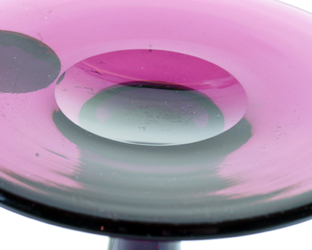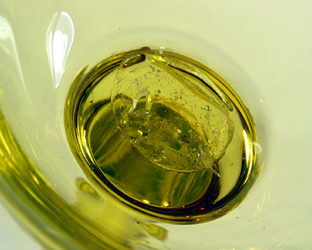Identification Features
This is a summary and generalization of specific characteristics that will aid you in evaluating and identifying the glass products made by The Pairpoint Corporation. For much more information in greater detail, we would encourage you to obtain a copy of our first book, "The Essence of Pairpoint" (Schiffer Publishing, Atglen, PA, 2001). One mistake and you will pay more than the price of this very comprehensive and easy to use book.
Balance of Design: Look for graceful flowing lines, completed curves, and a balanced "look." "Clunkiness" is not synonymous with Pairpoint.
Balance of Design: Look for graceful flowing lines, completed curves, and a balanced "look." "Clunkiness" is not synonymous with Pairpoint.
Sound: A light tap with your finger will bring forth bell-like tones and resonance.
Signatures: With one primary exception, Pairpoint did not sign their glass. On rare occasions, when specifically requested by a customer, Pairpoint may have used a diamond stylus to scratch their logo, a "P" within a diamond, on the underside of the foot.Tavern Ware items, which feature enameled decoration will almost always be signed under the foot with the catalog number and the decoration number. Otherwise be extremely wary of any glass item with a signature. With that being said, Pairpoint items of recent vintage will be regularly found with a fully-spelled-out stylized "Pairpoint" acid-etched signature. Also many items from the Bryden-era (approximately 1960s - 1980s) will display either a paper label or an enameled "Diamond P" within their decoration.
Bowl Bumps: Look for a gentle protrusion in the bottoms of bowls and open pieces where the application of the stem pushed the molten glass up during attachment.
Edge Finishing: Except for a few documented exceptions, expect to find all open edges finished by fire-polishing, NOT grinding. The presence of grinding usually indicates a repair has been made. Unless you must have the piece, or it is extremely hard-to-find, or it is really cheap, stay away from it.
Pontil Marks and Finishing: Pairpoint Glass was made by hand using the traditional blow-pipe and punty rod. Consequently finished products will display the presence of a pontil mark, usually under a foot or the bottom of a bowl; occasionally a pontil mark will be open and visible from the top. Except for some documented pieces, Pairpoint would grind and highly polish the rough surface left when the item was snapped off the punty rod at the conclusion of manufacture. Commonly referred to as "polished pontils," expect to find them present on Pairpoint products, as well as products that were hand-made by other quality glass companies of the period. Occasionally, an engraving design will call for the pontil to be finished with a design, but a gentle depression of the design in that center area will be evident.
Mold Marks: You will not find mold marks on Pairpoint glass products. Mold marks will appear as straight line protrusions, generally in tight areas of the design. They will be minimally noticeable as they represent imperfection. If you find one, there will be a second mark 180 degrees away. Some molds were of three parts, so expect to find three marks evenly spaced around the circumference.
Bubble Ball: While perfected at Pairpoint, the presence of a glass orb enclosing a pattern of small air bubbles, commonly called a "bubble ball," does not infer that the item is of Pairpoint origin. This design feature was used by other glass companies of all quality levels. The bubble ball was probably used by Pairpoint more than any other company. The Pairpoint bubble ball always displays the bubbles in a vertical spiraling configuration, while most others display total randomness or a straight vertical orientation. The misattribution to Pairpoint is extremely frequent, and many sales have been made to unknowing buyers. DO NOT rely on the bubble ball alone to attribute a glass item to Pairpoint.
Pairpoint also used the “ball” feature without the bubbles. A “hollow ball” was occasionally used as a design variant and is a very desirable feature to find. Sometimes the hollow ball will be in the same color as the predominant color of the item. A swirling (twisted) ball was used during the Gundersen-era, in addition to the bubble ball.










